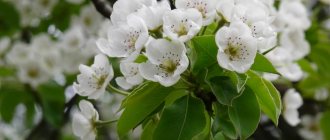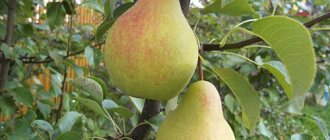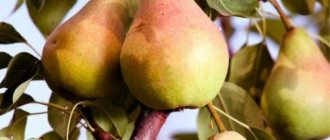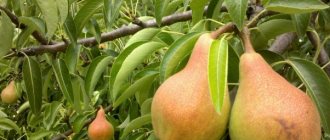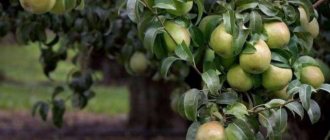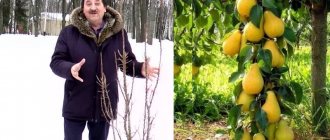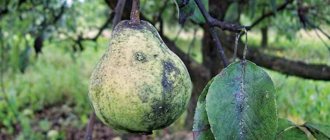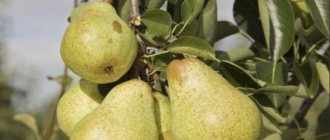- Collection and storage
The autumn pear variety “Conference” has existed for more than a hundred years and is well known to several generations of domestic gardeners. It is distinguished by the excellent taste of the fruit and its unique shelf life. These pears are suitable for fresh consumption almost until the very end of spring.
“Conference” is in demand in industrial and amateur gardening; it is successfully grown in the southern and southwestern regions of Russia, in many post-Soviet countries
The variety is considered a “world classic” of fruit and seed crops. In the article we will talk in detail about the optimal growing conditions and features of caring for this pear. Let's start with the most significant characteristics:
| Parameter | Characteristic |
| Culture | Pear (Pyrus communis L.) |
| Variety | "Conference" |
| Tree height | Medium or vigorous: from 2.5 to 8 m (depending on the rootstock) |
| Precociousness | On the 3-4th or 5-7th year after planting (depending on the rootstock) |
| Timing of fruit ripening to the stage of removable (technical) / consumer ripeness | Autumn / late autumn: second ten days of September - early October / late October - early November |
| Period of consumption (storage) | Autumn-winter: fruits are stored for 180-240 days (under proper conditions) |
| Type of fruiting | Mixed: on simple and complex rings, spears |
| Fruit weight | About 140 g (up to 200 g) |
| Productivity | High, regular; on average 40 kg (maximum 60 kg) per tree, up to 21 t/ha (in industrial plantings) |
| Appearance of fruits | Large, one-dimensional, elongated pear-shaped. The skin is harsh, dense, matte. The color of the peel when removed is greenish-yellow, with thick rusty spots. There are no subcutaneous points. The peduncle is thick, short or medium-sized, arched. Funnel with half-open or open cup |
| Pulp | Pinkish-creamy, tender, buttery, melting, juicy |
| Tasting assessment of taste qualities | 4.8-4.9 points (out of 5) – the taste is sweet, without astringency, with a fragrant aroma |
| Purpose of fruits | Dessert (table): intended primarily for fresh consumption |
| Sustainability | Winter hardiness is weak (up to −20 ℃), drought resistance is average; relatively resistant to scab and bacterial diseases, highly susceptible to thermal leaf burn |
| Year of inclusion in the State Register of the Russian Federation | 2014 |
| Recommended growing regions | North Caucasian (6) |
| Originator | Institute of Horticulture of the Ukrainian Agrarian Academy of Sciences (Kyiv) |
Origin and zoning
There is no information about breeding work to breed the “Conference” in open sources. There is some evidence that the plant is a seedling from free pollination of the Leon Leclerc de Laval pear with wild varieties, accidentally discovered by the English amateur breeder Thomas Francis Rivers in 1885 in a family nursery located in Sawbridgeworth (Hertfordshire). Ten years later, the new variety was demonstrated at the “British National Pear Growing Conference”, after which the Conference was named. Currently, it has a reputation as one of the most unpretentious, productive and extremely tasty, therefore it is actively cultivated on an industrial scale in Western and Eastern Europe, as well as in China and the USA.
Foreign fruit growers classify Conference as one of the leaders providing record productivity, high marketability and taste of fruits
Since the late 60s of the last century, state tests of the variety have been carried out in experimental plantings of the USSR. In 1975, it was included in the Ukrainian register of selection achievements, in 2005 – in the Belarusian register, and in 2014 – officially registered in the State Register of the Russian Federation. Due to its low winter hardiness, this pear was recommended in Russia for cultivation in the North Caucasus region, in Ukraine - in the forest-steppe zone and Polesie, in Belarus - in the Brest, Gomel and Grodno regions. The variety is ideal for home cultivation in most post-Soviet countries with warm climates, where it demonstrates excellent taste, marketability, excellent transportability and keeping quality of fruits with regular high tree yields.
You can learn more about the features of the “Conference” in the video filmed by a Vitebsk amateur gardener:
Pear Conference
Pear is a widespread, unpretentious fruit tree that can be successfully grown in any garden. Breeders annually develop new varieties of this crop with unique properties and characteristics. Among the huge variety of existing varieties, the Conference pear has withstood serious competition for more than 100 years and is popular among gardeners all over the world. Wide popularity and demand over a long period of time is justified by the excellent agrotechnical characteristics of the variety and the remarkable quality of the fruit. Thus, the “Conference” pear is grown today not only in personal plots, but also in gardening farms. Fruits of this variety can often be found on store shelves. Growing a fruit tree with your own hands is quite simple. In our article we will provide detailed guidance on how to do this and provide a description of the “Conference” pear, photos and reviews of this legendary variety.
Features of the plant, its pollination and fruiting
The tree is medium or vigorous (depending on the rootstock), with a dense, wide-pyramidal crown. The bark on the trunk and main branches is gray and smooth. The skeletal branches extend from the trunk at an angle close to a straight line, with their ends directed upward. The shoots are medium thick, geniculate, covered with brownish-brown bark, with a few lentils. The branches are heavily leafy, strong, able to withstand the weight of a ripening crop without breaking. The leaves are medium-sized, dark green, matte, with curled tips and serrated edges.
The sparseness and compactness of the crown of pyramidal trees is achieved by cutting off the branches to the inner bud and then bending the shoots growing upward to the desired position (at an angle of 45°)
The tree is distinguished by high bud permeability and shoot-forming ability. Fruiting is of mixed type: mainly concentrated on spears, simple and complex ringlets, partly on fruit twigs; In southern gardens, the harvest is often formed on last year's growths. During the season, shoots can grow up to 60 centimeters. Such active growth requires regular and thorough thinning of the crown by removing entire branches to transform some of the strong ones into overgrowing ones.
The variety is classified as self-fertile and is considered a good pollinator for other pear trees. “Conference” is capable of forming ovaries in the amount of 20-40% of the total mass of flowers, but to increase productivity it is recommended to plant it together with “Bere Giffard”, “Williams”, “Bere Bosc”, “Bere Gardi”, “Good Louise”.
Precocity and productivity
The early fruitfulness of the variety is assessed as high. Trees on vegetative (clonal) rootstocks, for example, quince C, BA-29, Sido, Adams, begin to bear fruit in the 3-4th year after planting in a permanent place. Fruit plants grafted onto quince have a height of 2.5-4 m, and the duration of their productive period is 30-40 years.
Experts advise growing trees on clonal rootstocks where the groundwater level does not rise above 2.5 m
Pears on a vigorous seed rootstock can grow up to 5-8 meters in height and bear fruit for 50-70 years, and sometimes longer, without showing a tendency to periodicity. Such specimens have a powerful tap root system that goes deep into the ground, so the groundwater level should be no higher than 3 meters from the surface.
Up to 60 kg of fruits are harvested from one mature tree in the fall. The yield during the period of full fruiting in industrial plantings is up to 21 t/ha (about 42 kg per tree).
Fruit characteristics
The fruits are heterogeneous, large in size (on quince) and medium-sized (on seed rootstock), weighing about 130-150 g (up to 180-240 g), elongated pear-shaped or “bottle-shaped”. According to reviews from gardeners, fruit shrinkage can be observed during dry periods, when pruning principles are not followed, and also when trees experience maximum stress in the form of abundant (unstandardized) harvests. Pears are covered with a tough, dense, matte skin. The color of the peel when removed is greenish-yellow, with thick rusty spots. There are no subcutaneous points. A funnel with a half-open or open cup. The stalk is thick, short or medium in size, and has an arched shape.
Depending on the growing region, the fruits reach technical ripeness in mid-September - early October
The pulp is pinkish-cream, tender, oily, melting, juicy. It is very sweet, with a pleasant taste, without astringency. Professional tasting assessment of taste – 4.8-4.9 points (out of 5). Many summer residents call the taste very sweet with a subtle sourness and note a strong aroma.
Experts who conducted field tests in the Kuban horticultural zone of the Krasnodar Territory (2015) noted that the fruits of the “Conference” have a high content of biologically active substances, including antioxidants, can withstand long-term storage, preserving beneficial properties, and therefore can be used for development and production of functional food products.
Pears finally ripen 60-90 days after picking
Biochemical studies carried out on the basis of the Grodno Zonal Institute of Plant Growing of the National Academy of Sciences of Belarus and the Kuban State Agrarian University showed that pears at the stage of harvest ripeness contain 16.8-17.3% dry matter, the ratio of sugars and acids (SAR) is at the level of 35, 9 . The fruit contains:
| Nutrients and beneficial substances | Quantity per 100 g of product |
| Ascorbic acid (vitamin C) | 3.6-8.1 mg |
| Sahara | 8.3-10.4 g |
| Acids | 0.17-0.29 g |
| P-active substances (catechins) | 34.5 mg |
In addition to fresh consumption, Conference pears are suitable for canning, baking, a variety of desserts, and juices.
Collection and storage
When ripe, the fruits are firmly attached to the branches and are not subject to pre-harvest shedding. The harvest is harvested at the stage of technical maturity, usually in the first ten days of October. Fruits reach consumer ripeness, when the taste is fully revealed, from November-December, that is, they finally ripen in 1.5-3 months. The consumer period under proper storage conditions (temperature +2...4 ℃ and relative humidity 85-88%) can last 6-8 months.
The thick skin reliably protects the juicy pulp and is practically not injured during transportation.
The shelf life and transportability of the fruit are very high, so the variety is considered suitable for commercial cultivation and industrial processing.
General description of varieties
Columnar apricots are characterized by maintaining the natural size, taste and aroma of the fruit. Fruiting occurs on 1–3 main vertical branches and small fruiting branches. The trees are perfect for limited areas and are characterized by hardiness, frost resistance and ease of care.
- Columnar trees have a number of advantages:
- early onset of fruiting - 2-3 years;
- increasing the overall garden yield by 1 m² from 10–12 kg/m² to 15 kg;
- compactness and ease of maintenance of trees;
- during frosts they can be moved to a garage or barn, reducing the effect of frost on fruit buds;
- they can be moved from one place to another if necessary;
- they have the best decorative effect and at the same time consistently produce a harvest of excellent fruit.
- There are also disadvantages to planting in pots:
- Such a tree needs to be watered and fertilized more often.
- in addition, it may develop problems for no apparent reason, as a result of which the tree may die.
Resistance to diseases and pests
Like ordinary trees, columnar trees are also subject to attacks by pests and diseases. But at the same time they are considered quite resistant to them. Insects cannot cause significant harm to a healthy, powerful tree. Therefore, the gardener needs to take care of disease prevention and this will be enough.
Did you know? It is quite possible to grow a new spike-shaped apricot from a seed.
But the new plant will not necessarily be completely identical to the existing one, since the columnar gene is inherited only in 40% of cases.
Drought resistance and winter hardiness
Columnar trees can only be partially drought-resistant. They don't have very large roots and need more frequent watering than regular trees. If the tree is not planted in the ground, but grows in a container, then its roots may freeze in winter. To prevent this from happening, the container with wood is insulated for the winter with straw mats or other material.
Flowering and ripening times
Apricot is the first tree to bloom in spring. And the flowers appear on it before the leaves. To start flowering, it is necessary for a stable positive temperature to be established.
Therefore, on the Black Sea coast of Crimea, flowering begins in March or early April, but beyond the Urals - after April 20. 40 days after the formation of the ovaries, early apricot varieties will ripen: Lel, Medovy, Melitopolsky.
Among the columnar species, there are no such early specimens. All of the above trees produce crops from the third decade of July and early August.
Productivity
The average yield of columnar apricots is 15–18 kg per tree. Very high yield - up to 35 kg per plant.
Transportability
Transportability of fruits is standard: when transporting fresh, undamaged fruits in cardboard or wooden packaging, up to 90% of the goods are preserved. The shelf life of fresh apricots is 2–4 weeks.
Read more about how to dry apricots for dried apricots.
Application
Of course, first of all, apricots are intended for fresh consumption. Their excellent taste makes this possible.
Apricots can add their characteristic flavor and delicate texture to both savory main courses and sweet desserts.
But if you have a large harvest, then the collected fruits can always be processed into juices, compotes, preserves, jams, made into dried fruits and frozen.
And the trees themselves are used to decorate the site. Some of them can be installed in a recreation area, near a gazebo, and even made into something like a hedge. Columnar varieties are ideal for limited space in the city, namely for balconies, terraces or small gardens. But these trees can also be planted in the ground, creating an ordinary garden.
Specifics of cultivation and agrotechnical recommendations
Many gardeners prefer to plant “Conference” in the spring, since seedlings of this variety are not highly frost-resistant. Over the summer, the young tree has time to take root well, form a sufficient number of new roots and adapt to a permanent location. If you follow standard agrotechnical recommendations, the pear takes root well and tolerates the winter months normally. When purchasing seedlings, you need to make sure that the plants are protected from bright sunlight and the roots remain sufficiently moist.
The best option is to purchase two-year-old pear seedlings from a nearby nursery that specializes in the propagation and cultivation of fruit crops and has a good reputation among gardeners. If necessary, experienced staff can also provide assistance in selecting pollinator varieties.
Seedlings with open and closed root systems are available for sale.
In plants with an open root system, you can examine the roots and assess their condition. They should be strong, elastic, well branched and slightly moist. Such a seedling should be purchased only in a leafless state. Plants sold in special containers are allowed to have leaves, since the roots are not injured during transplantation along with the lump of earth in which they grew.
Planned work begins with choosing a landing site. As a rule, the northern, northwestern or northeastern parts of the garden plot, protected from the wind, are considered the best for pears. At the same time, the tree must be given sufficient space, which depends on the type of rootstock and other parameters. The minimum distance between pears on medium-sized rootstocks should be 4-5 meters. Vigorous trees are usually located no closer than 5-6 meters from each other.
It is advisable to prepare the planting hole in advance - in the fall or at least a few days before planting in the spring. As soon as the soil thaws, a hole about 70 cm deep and 1 m in diameter is dug in the selected location. For seedlings on medium-sized rootstocks, a depth of 50 cm will be sufficient. When digging, the top fertile layer of soil is poured into one place, and the less fertile lower layer into another.
For subsequent fixation of the seedling, it is recommended to install a peg about 1.5 m long in the planting hole so that it rises about 0.5 meters above the soil level
At the bottom of the pit (2/3 of its volume) pour soil from the fertile layer, mixed with fertilizers: organic (1-2 buckets of rotted compost) and mineral (200-300 g of superphosphate and 50-70 g of potassium chloride). A few days later, after the earth has settled a little, a small elevation is formed around the peg, on which the plant’s root system can be well straightened. The seedling is placed in a hole on the north side of the peg, evenly distributing the roots. Having covered them with earth, the tree is shaken so that there are no voids left between the roots. The soil is compacted by lightly trampling it with your foot in the root zone, and loose soil is added again. At the same time, monitor the position of the root collar - it should be approximately 5 cm above the surface of the earth. Too deep placement leads to poor survival rate and slower growth; too high - to drying out of the roots, as well as the appearance of dense rootstock.
The tree is watered abundantly; it requires at least three buckets of water. When the water is absorbed into the soil, a layer of soil or peat about 5 cm thick is poured on top to prevent excessive evaporation of moisture. The seedling is strengthened by tying it to a peg with a rope.
Further agrotechnical measures are carried out according to standard rules for caring for fruit trees.
For successful rooting, the plant must be provided with sufficient watering, especially in hot, dry weather.
In the first years after planting, young trees are pruned in order to form a compact crown and create a strong skeleton. The tops of planted annual seedlings without a crown are removed to prevent a strong increase in the height of the trunk and to ensure good growth of shoots. For medium- and vigorous-growing specimens, it is recommended to leave a trunk 60-70 cm high.
After planting, the central conductor and skeletal branches of one- and two-year-old seedlings with a crown are cut off. First, the upper skeletal branch is shortened by about half, all those located below are cut so that their ends are at the same level as the upper one, and the central conductor is 20-25 cm higher.
To form the lower tier of the crown, 3-4 skeletal branches are left, growing at an angle of at least 45° to the central conductor and located at a distance of 10-12 cm from each other. Excess shoots are cut into a ring.
After the formation of the crown of the pear is completed, the shortening of growths is stopped and thinning is carried out in order to lighten it.
Tree trunks need to be regularly cleared of weeds or mulched with peat, straw, humus and other materials that prevent their growth and evaporation of moisture from the soil.
In autumn, in order to protect young trees from frost, the trunks are hilled to a height of about 30 cm, and the tree trunk circles are mulched. To prevent hares and mice from damaging the bark, the trunk is wrapped in reeds or wrapped in fine mesh. You can read more about ways to protect young fruit trees from rodent pests in the winter in the article on our website.
Tree care
Proper planting of pear seedlings The conference is only the beginning of the path to obtaining a tasty and abundant harvest, because the effectiveness of growing crops largely depends on further tree care. Watering, fertilizing, pruning and pest control are the main activities when growing trees of this variety.
Irrigation rules and regulations
Conference pear is a representative of drought-resistant varieties, so only young plants (up to four years of age) require abundant and regular watering, and in the future, 3-4 procedures for the entire season will be enough for them. Seedlings are watered approximately once every 14 days, spending about 1–2 buckets of water per plant.
In hot summers with consistently high air temperatures, the frequency of watering can be increased to once every 7 days, and in the rainy season, on the contrary, the abundance of watering can be reduced, focusing on the rate of drying of the top soil layer.
Timing and rates of fertilizer application
Any plant needs nutrients, because if they are lacking, successful growth and fruiting of the crop cannot be guaranteed. When growing pears of the described variety until the seedlings are three years old, they are fed no more than twice a season: in the spring, using urea or other nitrogen-containing substances, and in the fall, adding rotted manure to the ground (0.5 l, pour 10 l of water and leave to infuse in within 5–7 days).
Before using slurry directly, it is better to dilute it again with water (1:10), and then pour the fertilizer into the tree trunk circle. A good option for feeding pears would be complex mineral formulations for fruit trees, which are best applied to the soil before the trees flower, but always in the dosage recommended by the manufacturer.
Crown trimming and shaping
Features of formative pruning of pear Conference depend on the purposes of growing the tree. Thus, when growing crops privately, gardeners prefer sparsely layered formation, while when planting trees in industrial quantities, it is recommended to carry out palmette formation. The first option involves removing all excess growth, except for 4–5 powerful skeletal shoots. Subsequently, the trunk and selected branches are cut to ¼ of their length.
In the second case, a supporting trellis is immediately installed next to the tree, to which the skeletal branches are gradually tied, bending them one at a time perpendicular to the tree trunk. In this case, only sanitary pruning is provided to remove weak, diseased and broken shoots. In addition, when forming fruits on trees, it is worth leaving only large and healthy specimens, removing excess twisted green fruits.
1. The first pruning is done in relation to young seedlings, as soon as they have reached the age of 1 year. Cut off the top, this will ensure the growth of the lower branches, so the crown will be formed starting from the lower shoots. 2. The next season involves exactly the same pruning, only of the upper tier of branches.
Preparing for winter
In almost all regions (except for the southern territories of the Russian Federation), the Conference pear needs good winter shelter, since even when temperatures drop to -18°C, freezing of adult and mature shoots, not to mention young branches, is possible. If in the south of the country it is enough to sprinkle the lower part of the tree with a 30-centimeter layer of humus, then for the northern winter such actions will not be enough and you will have to additionally wrap the pear trunk with agrofibre, placing a layer of spruce branches on top.
In the Moscow region, young plants are bent to the ground and covered with a thick layer of mulch, also covered with spruce branches or spunbond. With the arrival of stable spring warmth, as soon as the threat of return frosts has passed, it is necessary to remove the mulch, allowing the roots access to air.
Advantages and disadvantages
The variety, like any other variety of crop, has its advantages and disadvantages, but it has many more advantages:
- excellent taste of the fruit;
- beautiful presentation;
- good transportability and long shelf life subject to temperature conditions;
- versatility of use;
- regular yield;
- relatively high resistance to leaf and fruit scab;
- precociousness.
With properly organized storage, pears do not lose their marketable and consumer qualities for 180-240 days
Experienced fruit growers and farmers the disadvantages of the “Conference”:
- average drought resistance - during hot periods the tree needs regular watering;
- low frost resistance - the maximum permissible temperature for them in winter is −20 degrees. In spring, flowers often suffer from recurrent frosts. It is better to purchase seedlings from nurseries located nearby so that the plants are maximally adapted to the local climate;
- large dimensions of trees on seed rootstock;
- susceptibility to thermal burn of leaves.
Major diseases
According to reviews from gardeners, the Conference most often suffers from scab, rust, moniliosis and sooty fungus. Diseases can be prevented and treated with the help of copper-containing preparations and fungicides.
Only preventive measures are effective against pests, because the appearance of flower beetles or fruit-eating caterpillars can be noticed too late.
The conference is yet another proof that appearances are deceptive and that behind the unpresentable appearance of fruits there is a real treasure hidden. Therefore, if you live in regions with a warm climate, be sure to pay attention to this variety.
Reviews from gardeners
Konstantin, 62 years old, Krasnodar
There were no difficulties in purchasing seedlings of this variety; they were found in a nearby nursery 12 years ago. The tree has taken root well. We chose a sunny, open place for it, filled the hole well with fertilizers and left a large enough space around to allow a powerful root system to develop. Now it is actively bearing fruit, producing 50-60 kg every year. Pears ripen by the end of September; we pick them in early October while they are still “stone”. Be sure to let them sit for a couple of months, then they become soft. The pulp is juicy and sweet. In appearance and taste they resemble Bere Bosc, but much juicier.
Natalya, 41 years old, Kharkov
We harvest the Conference at the end of September, while the pears are still hard and unripe. We wrap each one separately in paper, put it in wooden boxes and store it in the cellar until the end of April. The longer they sit, the sweeter it becomes. In December, their taste is simply incomparable: honey, without a single hint of sourness. The pulp is juicy, melting, and the skin is harsh and dense. I like it when the peel becomes softer, but this is not for everyone.
Regina, 53 years old, Cherkassy
Pears hold on to the branches very tightly; even until the beginning of November they can hang at the very tops without falling off. In dry years, they are usually small - 100-120 grams. The tree needs constant care. Over the years, I have discovered a pattern that with regular watering and timely pruning, the fruits are always large. The yields are decent and are stored for a long time, almost all winter. The real taste is acquired at the beginning of winter. From each tree we remove from 40 to 80 kg. We mostly eat them fresh. They are sweet and fragrant, well suited for making baked goods with fruit.
